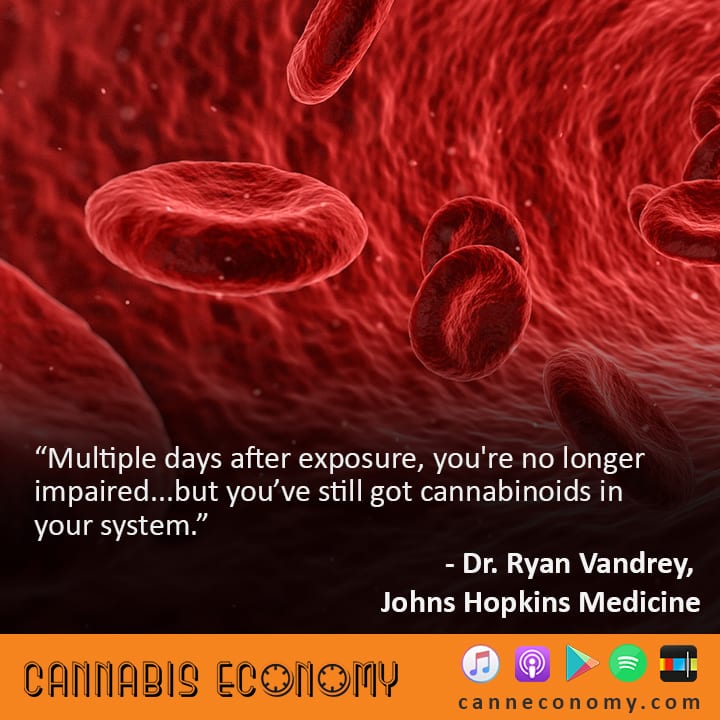
Ep. 463: Ryan Vandrey PhD
August 22, 2019Dr. Ryan Vandrey, of Johns Hopkins University, joins us to discuss the best routes of administration for different conditions. For example, when treating chronic pain, oral administration is preferable, as it yields a more sustained drug effect. However, with a symptom like nausea, inhalation would likely be the preferred route of administration, as eating or drinking may aggravate the nausea. As well, Vandrey talks about the flawed methods of testing THC levels in blood: “If we take somebody who uses cannabis frequently and they don’t use for 24 hours, they have as much THC in their blood as the person who’s eating a 50-milligram edible and is highly impaired. So, blood THC levels are incredibly complicated. What you have is a high likelihood of erroneous assumptions based on blood THC levels.”
Transcript:
Seth Adler: Dr. Ryan Vandrey joins us. Welcome to Cannabis Economy. I'm your host, Seth Adler. Download episodes on CannEconomy.com, that's two N's and the word economy. This is another one of those sessions from the digital workshop. So you can hear it here, you can see it there on CannEconomy.com along with all the other sessions. First a word from Wana Brands, and then Dr. Ryan Vandrey.
Seth Adler: Want to know with Wana Brands. Nancy, just general expansion into other states, what are you thinking?
Nancy: We are in such an active period right now. We have many, many states that we're in serious discussions with, but some of the most far along discussions are Ohio, California, you've heard of California. So that's an exciting one for us. Massachusetts, Maryland, and Pennsylvania. And we're looking at Washington, Michigan. We are quite in an expansion mode right now.
Seth Adler: Okay. We've got Dr. Ryan Vandrey.
Dr. Vandrey: Hi, Seth.
Seth Adler: Thanks for doing this. Yeah, really appreciate that we kind of finally... Right? We've been organizing this thing for a while, and here we are. Roots of administration and drug testing, we are truly talking about the science of cannabis, and I very much appreciate your time here and all of the work that you've done to date. To that end, I know that you have at least a fair amount of an opinion on pharmaceutical cannabinoids as it relates to your work, as it doesn't relate to your work. When we bring up pharmaceutical cannabinoids, in your mind, what are we talking about?
Dr. Vandrey: So we're talking about what you see in the background here. These are drugs that have gone through the traditional drug evaluation and approval process. They're approved by regulatory bodies like the FDA, World Health Organization, or European Health Monitoring, Health Canada, those kinds of things. So the difference here are that these are developed for a specific indication. You have a defined dose, and you know you got quality control and assurance that go behind these things.
Seth Adler: Okay. Let's dive into your laboratory research and why you would care about the former slide.
Dr. Vandrey: Yeah. Well, I mean, the former slide is one thing. The contrast to that is what you get in dispensaries. What we have the pharmaceutical cannabinoids that research that has been done to get those products to market is really well done. It's very rigorous, and we know a lot about those products. So we know the effects that they have. We know side effect profiles or adverse event profiles, and we know again what is in the container and what the dose is and what that does to the individuals who are tasked with taking it. When you get outside of the pharmaceutical space, we have the kind of state legal, quasi legal retail cannabis space, and it's medicinal, it's non-medicinal. We get a huge variety of products that are taken a number of different ways. Different chemical constituents and we need more data to understand what types of effects those products have on healthy adults.
Dr. Vandrey: So we've been doing a number of research studies in my lab where we recruit healthy adults to come in and we acutely dose them with different types of cannabis products. These products are sourced from the federal drug supply. So we're not going to dispensaries and just giving people stuff we don't know enough about. We're getting cannabis from the federal government, and then we can administer it in a number of different ways. So we have people, for example, smoke it, eat it, vaporize it, and we look at these different roots of administration and try to use a couple different doses to try to help understand what kinds of drug effects people are going to have when they take products, cannabis products these ways and help kind of characterize what would happen to a healthy adult. So we kind of modeling the scenario of somebody going on a ski vacation in Colorado, they stop off at the dispensary on I70, and this is what we can expect.
Seth Adler: So we don't have a federal network of labs. So we can't be all on the same page with what's in the cannabis. So I understand what you're saying as far as wanting and needing to go through the federal government to get the cannabis that you're utilizing. But what do you say to either industry folks or just a regular person like me who might say, "Hey, that federal government cannabis, with all due respect sir, is not quite the same as what's really out there." What do you say to-
Dr. Vandrey: Well, what's really out there is also incredibly diverse, right? So what you can get in even within one dispensary in one location has incredible diversity. So we're trying to slowly get away and understand what types of variables impact outcomes. When we're talking about outcomes, it could be subjective drug effects, it could be cognitive performance effects, it can be results on drug tests. So if you go to Colorado and you hit the dispensary, what's going to happen if you get work placed drug tested when you get back the next week. So we're trying to understand in the scenario of a single exposure, what happens from a number of different lenses, number of different angles. So we've been focused early on with root of administration because that's a big variable and potentially big impact.
Dr. Vandrey: Now more recently, we're starting to delve into the chemical composition, right? So what happens if there's a higher amount of CBD versus THC? What do pure cannabinoids looks like? What do pure terpenoids look like? What do they look like when they're mixed together? So those are the types of questions that we're getting to now. I'm probably getting ahead of where we're going with the talk. But that's a little teaser, right?
Read the full transcript:
Become a member to access to webinars, quarterly reports, contributor columns, shows, excerpts, and complete podcast transcripts
